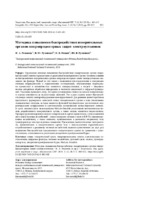| dc.contributor.author | Романюк, Ф. А. | |
| dc.contributor.author | Румянцев, В. Ю. | |
| dc.contributor.author | Новаш, И. В. | |
| dc.contributor.author | Румянцев, Ю. В. | |
| dc.coverage.spatial | Минск | ru |
| dc.date.accessioned | 2019-10-03T11:48:22Z | |
| dc.date.available | 2019-10-03T11:48:22Z | |
| dc.date.issued | 2019 | |
| dc.identifier.citation | Методика повышения быстродействия измерительных органов микропроцессорных защит электроустановок = Technique of Performance Improvement of the Microprocessor-Based Protection Measuring Element / Ф. А. Романюк [и др.] // Энергетика. Известия высших учебных заведений и энергетических объединений СНГ. – 2019. – № 5. – С. 403-412. | ru |
| dc.identifier.uri | https://rep.bntu.by/handle/data/57532 | |
| dc.description.abstract | Предложена методика повышения быстродействия измерительного органа микропроцессорной защиты и рассмотрена ее реализация на программном уровне. Основное влияние на быстродействие измерительных органов микропроцессорных защит электроустановок оказывают два фактора. Первый из них связан с появлением при повреждениях в измеряемых сигналах апериодических и гармонических составляющих, обусловленных переходными процессами и нелинейностью элементов электроустановки, а второй – инерционностью алгоритмов обработки информации, в частности аналоговой и цифровой фильтраций. Указанное приводит к тому, что время установления сигнала на выходе измерительного органа затягивается до недопустимых значений. Это в ряде случаев делает быстродействующую защиту электрооборудования малоэффективной. Для решения данной проблемы предлагается формировать выходной сигнал измерительного органа в виде специальных эквивалентных сигналов, которые являются функцией предварительно рассчитанного корректирующего коэффициента и ортогональных составляющих контролируемого сигнала. В среде динамического моделирования MatLab-Simulink реализованы математическая модель разработанного измерительного органа, а также модель элементов энергосистемы. Проверка функционирования модели измерительного органа проводилась с использованием двух видов тестовых воздействий – синусоидального сигнала с частотой 50 Гц (идеализированное воздействие), а также сигналом, приближенным к реальному вторичному току трансформатора тока при коротком замыкании. Проведенные вычислительные эксперименты, применительно к измерительному органу тока с использованием гармонического и приближенного к реальному тестовых воздействий, выявили существенное (до двух раз) повышение быстродействия предлагаемого измерительного органа по сравнению с существующими, основанными на реализации дискретного преобразования Фурье. | ru |
| dc.language.iso | ru | ru |
| dc.publisher | БНТУ | ru |
| dc.title | Методика повышения быстродействия измерительных органов микропроцессорных защит электроустановок | ru |
| dc.title.alternative | Technique of Performance Improvement of the Microprocessor-Based Protection Measuring Element | ru |
| dc.type | Article | ru |
| dc.identifier.doi | 10.21122/1029-7448-2019-62-5-403-412 | |
| local.description.annotation | The technique is proposed to improve the performance of the measuring element of microprocessor-based protection and its implementation is considered at the software level. Two factors mainly influence on the performance of the measuring elements o f microprocessorbased protection of electrical installations. The first one is associated with the appearance of aperiodic and harmonic components in the measured signals due to transients and nonlinearity of the electrical installation elements, and the second–with the inertia of information processing algorithms, in particular–with analog and digital filtering. This leads to the fact that the signal determining time at the output of the measuring element is delayed to unacceptable values that in some cases makes the high-speed protection of electrical equipment ineffective. To solve this problem, it is proposed to form the output signal of the measuring element in the form of special equivalent signals, which are a function of the pre-calculated correction factor and orthogonal components of the controlled signal. In the MatLab-Simulink dynamic modeling environment a mathematical model of the developed measuring element has been implemented, as well as a model of the elements of the power system. Checking the functioning of the model of the measuring element was carried out with the use of 2 types of test effects, viz. a sinusoidal signal with a frequency of 50 Hz (idealized effect), as well as a signal close to the real secondary current of the current transformer in case of short circuit. Computational experiments carried out in relation to the current measuring element using harmonic and close-to-real test effects made it possible to reveal a significant (up to 2 times) increase in the performance of the proposed measuring element as compared to existing ones based on the implementation of the discrete Fourier transform. | ru |

